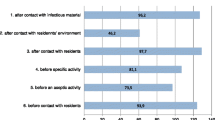Abstract
In an acute hospital, staff from the Renal Dialysis Centre (RDC) transported haemodialysis machines to patients in various wards to enable bedside dialysis. The bedside service was provided for patients who were not suitable for transfer to the RDC due to their medical condition. The haemodialysis machines, together with the Reverse Osmosis (RO) water machines were transported from the RDC to the wards on a daily basis. The objectives of the study were to evaluate the ergonomic stress on the staff transporting the machines; and any other occupational safety concerns that may arise from the transfers.
Access provided by CONRICYT-eBooks. Download conference paper PDF
Similar content being viewed by others
Keywords
- Healthcare
- Healthcare worker
- Occupational safety
- Push/pull force
- Transporting
- Haemodialysis machine
- Hospital
1 Introduction
The Renal Dialysis Centre (RDC) provided haemodialysis treatments to inpatients at the main Centre with 20 dialysis stations. In addition there were inpatients that were unsuitable for transfer to the RDC and for that group, 10 haemodialysis machines with the accompanying RO water machines would be transported from the RDC to the bed-side to enable bed-side dialysis. Those patients would include inpatients
-
(a)
in intensive care units;
-
(b)
in intermediate care units;
-
(c)
in isolation wards due to their medical condition; and
-
(d)
who were newly diagnosed with end-stage renal failure.
The machines were transported out of the RDC daily by the healthcare workers (HCW). Wherever possible, 2 HCW would transport the set of 2 machines. There were occasions when one HCW was observed to be pulling the haemodialysis machine while pushing the RO machine.
2 Methodology
-
1.
The workload of out-centre dialysis was evaluated for a typical month taking the number of cases requiring bed-side dialysis, distance travelled and time taken by the HCW transporting the machines.
-
2.
The initial and sustained push and pull forces required to move the haemodialysis machines and the accompanying RO water machines were taken for movement on a flat vinyl floor, movement into and out of the lift. The results were evaluated using the Snook tables of push/pull forces as used by the hospital’s Occupational Therapy department Ergonomics experts.
3 Results
3.1 Workload
In a typical month, bedside dialysis for a typical month showed the following:
-
(a)
409 cases
-
(b)
total distance travelled to transport the machines was 67 km
-
(c)
total travel time taken was 133 h (5 days and 13 h)
-
(d)
inpatient wards requiring the highest number of bedside dialysis were the Infectious Disease (130 sessions per month), Renal Medicine (94) and Respiratory and Critical Care Medicine (44) wards.
3.2 Machine Dimensions and Load
Data was taken for 3 models of haemodialysis machines that were in use and the RO water machine that was housed in its own trolley (Table 1).
3.3 Force Measurements
During the trial, the following were observed and taken into consideration for the measurements shown in Table 2:
-
(a)
The sustained push/pull force for moving the machines were insignificant, therefore the study focused on the initial push/pull forces.
-
(b)
Where possible, pushing was the preferred mode of action. Pulling action was only evaluated when pushing was not possible.
-
(c)
The activity of entering and exiting the lift were significantly more difficult and therefore the measurements were taken for these activities.
-
(d)
The Fresenius 4008 and Gambro 96 haemodialysis machines could be transported with or without additional loads of
-
i.
2 × 10 L of HD-1B Liquid Concentrate Bicarbonate reagents (A)
-
ii.
720 g Sodium bicarbonate (Bicart) and 350 ml SoftPac (B).
-
i.
-
(e)
The RO water machine was installed in a trolley and always transported with an additional load of 2 × 10 L of HD-1B Liquid Concentrate Bicarbonate reagents.
-
(f)
Push/pull forces were compared with tables of maximum acceptable push/pull forces (psychophysical limits) by Snook and Ciriello [1].
-
i.
The frequency of push for the haemodialysis machines was at the average of 5.5 initiation pushes per hour over a distance of 290 m per day.
-
ii.
As the readings exceeded the Snook table, we took the maximum distance and the maximum frequency. Thus, for pushing/pulling task to be safely done by 90 % female for 61.0 m travel at one push every 8 h over flat floor, the initial force should not exceed 16 kgf.
-
i.
When the machines were pushed out of the lift car onto the landing the following were observed which required the staff to exert extra effort overcome the resistance.
-
(a)
There was a very small gap of approximately 28 mm between the lift car and the landing.
-
(b)
The lift car floor was also observed to stop just very slightly below the landing.
4 Conclusion
With reference to the Snook Table Limit for 90 % of the female healthcare staff performing the task, the forces required to push the following machines in the following manner were within the recommended safe limit
-
(a)
Fresenius 4008 without load on flat floor;
-
(b)
Fresenius 5008 without load on flat floor;
-
(c)
Gambro 96 with and without load, on flat floor and into the lift; and
-
(d)
The RO water machine trolley with load on flat floor.
All other pushing activities with the machines exceeded the recommended safe push force limit with reference to the Snook Table Limit for 90 % of the female healthcare staff performing the task.
All pushing of the haemodialysis machines out of the lift was unsafe due to an incidental risk of the haemodialysis machines toppling.
The push forces for the haemodialysis machines (with or without load) exiting the lift car were not taken. For these machines, the pull forces were taken instead.
-
(a)
The 28 mm gap between the lift car and the landing proved too challenging to safely push the machines out of the lift as the wheels of the haemodialysis machines (70 and 75 mm diameter) were consistently trapped. An extra push was required to overcome that.
-
(b)
There was a risk of the slim and tall haemodialysis machines toppling over. It was not possible to measure the centre of gravity of the machines but the broadest side of the base to the height of the machines ratios were less than 1:2 (refer to Table 1). The in-built pumps, detectors and monitors were located on the upper half of the machines. The handles were also located near the top of the machines for ease of handling.
The RO water machine trolley’s wheels were 100 mm in diameter and did not face the same problem. As the RO machine was much shorter than the haemodialysis machines, it was also easier to push it over the gap without the fear of toppling.
5 Discussion
The push/pull forces required to push all the portable haemodialysis machines and RO water machine trolleys out of the lift exceeded the recommended safe limit for 90 % of female healthcare staff. That was unacceptable as the staff were required to perform multiple trips daily. The layout of the hospital made it necessary to use the lift to move between floors to the other inpatient wards.
9 months prior to the research, one senior staff nurse from the RDC reported difficulty pushing another haemodialysis machine, the Continuous Renal Replacement Therapy machine Prismaflex2. He reported having to exert force to push the machine out of the lift as the wheels got stuck in the gap between the lift car and the landing. As a result, he sustained a backache injury with a long recovery period when he was absent from work.
The RO water machine trolley’s wheels were 100 mm in diameter and that could have contributed to its ease of moving out of the lift car onto the landing despite the gap and unequal floor height between the two. However, the size of the wheels of the haemodialysis machines could not be changed as the modification was not supported by the manufacturer and sales agent and would render the machine warranties null and void.
The gap between the lift car and the landing and the slight dip of the lift car floor could not be rectified by the lift maintenance personnel as the extent was inconsistent, could not be avoided and could probably be affected by the load of the lift car when it was filled with equipment and passengers.
Bedside dialysis could not be avoided but the results from the study were used to successfully augment a proposal to relocate some hemodialysis machines to the inpatient wards that had the highest requirement. In that way, the majority of the machines would not have to be transported from the RDC daily. That was an ideal solution to the problem as the other factors regarding the existing machine wheels and lift positioning could not be fixed.
Reference
Snook, S.H., Ciriello, V.M.: The design of manual handling tasks: revised tables of maximum acceptable weights and forces. Ergonomics 34(9), 1197–1213 (1991)
Acknowledgments
Staff from Office of Performance Management who assisted in data collection. Mr. Patrick Ker, Senior Principal Occupational Therapist and Director Postgraduate Allied Health Institute for advice and results interpretation. Support for conference travel from the Quality and Risk Management Network, Singapore General Hospital.
Author information
Authors and Affiliations
Corresponding author
Editor information
Editors and Affiliations
Rights and permissions
Copyright information
© 2017 Springer International Publishing Switzerland
About this paper
Cite this paper
Kam, W.K., Alkaff, M.F.b.A.K., Tan, P.G.P. (2017). Bedside Dialysis and the Occupational Safety and Health Impact on the Healthcare Worker in an Acute Hospital. In: Duffy, V., Lightner, N. (eds) Advances in Human Factors and Ergonomics in Healthcare. Advances in Intelligent Systems and Computing, vol 482. Springer, Cham. https://doi.org/10.1007/978-3-319-41652-6_6
Download citation
DOI: https://doi.org/10.1007/978-3-319-41652-6_6
Published:
Publisher Name: Springer, Cham
Print ISBN: 978-3-319-41651-9
Online ISBN: 978-3-319-41652-6
eBook Packages: EngineeringEngineering (R0)




